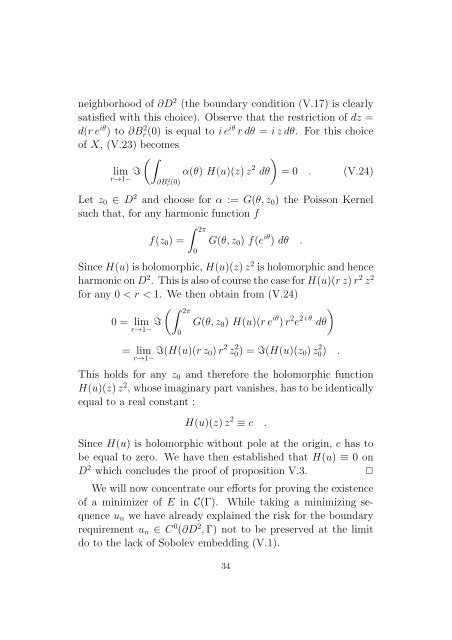Conformally Invariant Variational Problems. - SAM
Conformally Invariant Variational Problems. - SAM
Conformally Invariant Variational Problems. - SAM
You also want an ePaper? Increase the reach of your titles
YUMPU automatically turns print PDFs into web optimized ePapers that Google loves.
neighborhood of ∂D 2 (the boundary condition (V.17) is clearly<br />
satisfied with this choice). Observe that the restriction of dz =<br />
d(re iθ ) to ∂Br(0) 2 is equal to ie iθ rdθ = izdθ. For this choice<br />
of X, (V.23) becomes<br />
(∫<br />
)<br />
lim I α(θ) H(u)(z)z 2 dθ = 0 . (V.24)<br />
r→1− ∂Br 2(0) Let z 0 ∈ D 2 and choose for α := G(θ,z 0 ) the Poisson Kernel<br />
such that, for any harmonic function f<br />
f(z 0 ) =<br />
∫ 2π<br />
0<br />
G(θ,z 0 ) f(e iθ ) dθ .<br />
Since H(u)isholomorphic,H(u)(z)z 2 isholomorphicandhence<br />
harmoniconD 2 . ThisisalsoofcoursethecaseforH(u)(rz)r 2 z 2<br />
for any 0 < r < 1. We then obtain from (V.24)<br />
(∫ 2π<br />
0 = lim I G(θ,z 0 ) H(u)(re iθ )r 2 e 2iθ dθ<br />
r→1−<br />
0<br />
= lim<br />
r→1− I(H(u)(rz 0)r 2 z 2 0) = I(H(u)(z 0 )z 2 0) .<br />
This holds for any z 0 and therefore the holomorphic function<br />
H(u)(z)z 2 , whose imaginarypart vanishes, has to be identically<br />
equal to a real constant :<br />
H(u)(z)z 2 ≡ c .<br />
Since H(u) is holomorphic without pole at the origin, c has to<br />
be equal to zero. We have then established that H(u) ≡ 0 on<br />
D 2 which concludes the proof of proposition V.3. ✷<br />
We will now concentrate our efforts for proving the existence<br />
of a minimizer of E in C(Γ). While taking a minimizing sequence<br />
u n we have already explained the risk for the boundary<br />
requirement u n ∈ C 0 (∂D 2 ,Γ) not to be preserved at the limit<br />
do to the lack of Sobolev embedding (V.1).<br />
34<br />
)
















